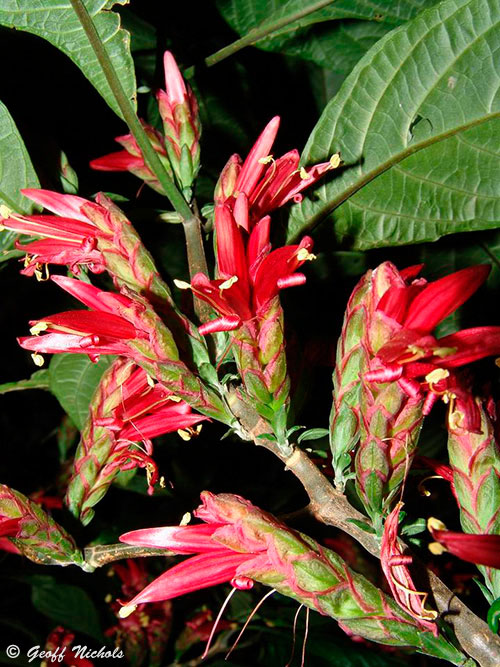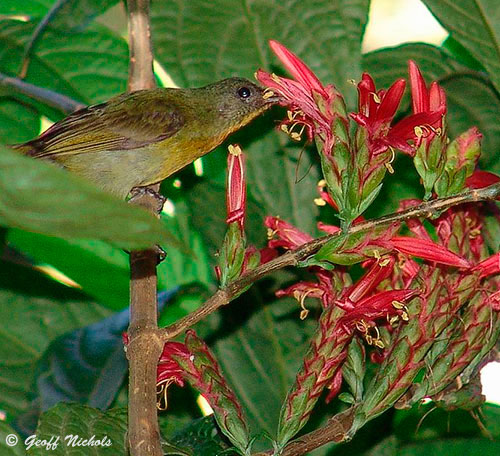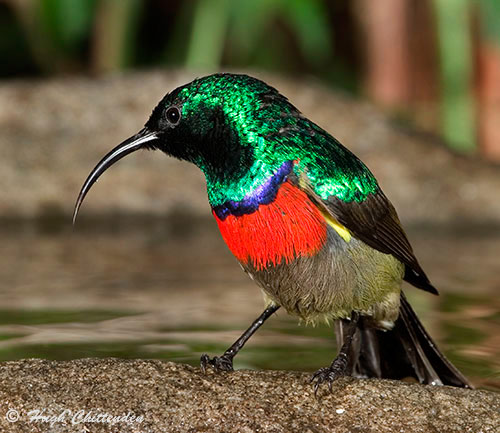sunbird common name for tropical, Old World birds, including more than one hundred species in the family Nectariniidae. Like the unrelated New World hummingbirds, to which sunbirds are often compared, sunbirds have long and slender, highly curved bills, tube-shaped tongues, and feed primarily on nectar and small insects. However, they perch when feeding rather than hovering as the hummingbirds do. They are typically small birds, with the largest, the great sunbird (
Dreptes thomensis ) reaching a maximum length of 8 1/2 in. (22 cm), and are native to forest and brush throughout Africa, Asia, and the South Pacific. Some common species are the variable sunbird (
Cinnyris venustus ), the purple sunbird (
Nectarinia asiatica ), and the golden-winged sunbird (
N. reichenowi ). The males of most species are brightly colored, with metallic, sometimes velvety, plumage. Out of breeding season, the males tend to take on the duller female plumage. Sunbirds may change their feeding grounds during the nonbreeding season but are not particularly migratory. They are not very gregarious, and males tend to be aggressive, especially during breeding season. Sunbirds build a characteristic purselike, hanging nest, into which the female deposits her two, rarely three, white or pale blue, variously spotted or striped eggs. Two unrelated Madagascan species in the genus
Neodrepenis are known as false sunbirds, and are easily confused with the sunbirds, which they resemble in habits, habitat, diet, and somewhat in appearance. They are, however, slenderer and shorter-legged, with more markedly down-curved bills. The related spider hunters, of the genus
Arachnothera, are members of the true sunbird family and are found in Asia. They lack the metallic coloration of their sunbird relatives, and the sexes are more alike, both being dull greens, browns, or yellows. Spider hunters (e.g., the little spider hunter,
A. longirostris ) feed largely on insects and spiders. Their singular cup-shaped nest is built on the bottom of a broad leaf and attached firmly by cobwebs and plant fibers, which the bird sews and knots together. Both sexes build the nest and share incubation of the two to three eggs laid per clutch. Sunbirds and their relatives are classified in the phylum , subphylum Vertebrata, class Aves, order Passeriformes, family Nectariniidae.

Red Sunbird Bush – tops for nectar
Metarungia pubinervia
The real botanists and experts in the
Acanthus Family - Trevor Edwards in Pietermaritzburg, Kevin Balkwill in Johannesburg, Brian Schrire and the Kaj Vollesen at Kew Gardens in the England helped us to give this plant its real name,
Metarungia pubinervia Red Sunbird Bush or Rooisuikerbekkiebos. The Latin species name of pubi – hairy and nervia - nerves or veins is apt because under the leaves the main veins are covered in fine hairs. The lag time in getting plants identified was cut dramatically by using digital photography to send images over the internet to the other side of the world and get an answer in hours rather than days or weeks.
The Krantzkloof Nature Reserve is a deep gorge cut through the Natal Group Sandstone by two main rivers the Molweni and Nkutu, that help form the escarpment between the coastal plain and the interior inland of Durban.
Surrounded by a sea of suburbia above, and a semi-formal settlement below, the Krantzkloof gorges are a life raft for a vast number of plant species, many rare or endangered. Some are near local endemics, and one of these,
Brachystelma natalense, is believed extinct except for the area’s last small population.

At about 1 500 hectares the gorge system is Durban’s largest remaining natural area and a unique remnant of what existed a brief 150 years before a tidal wave of settlement, suburbia and sugarcane engulfed the KwaZulu-Natal coast.
Continuing residential development continues to whittle away at the natural area, with the greatest impact on grasslands on the gorge plateaus. Yet much of the remaining natural area survives because of its difficult terrain, and a core area of 584 hectares is protected within the Krantzkloof Nature Reserve, which was proclaimed in 1950.
This gorge has yielded surprises over the years and now with the keen eyes of this band of enthusiasts at least 20 species new to the Durban Metropolitan Region have been unearthed and amongst this list is the plant I am going to describe to you.
There are literally thousands of specimens from relatively large shrubs of around 4-5 metres tall down to the youngest seedlings and suckers that develop when a plant is damaged and the stem touches the soil it roots to form another plant. A KZNCS Game Guard, Eseu Dlamini has discovered another group of plants, in his patrols through the dense bush in the Gorge. These plants grow on the south facing slopes of the gorge in virtually full shade for most of the year.
When we first visited the site to photograph this species with other “plant nutters” the mature specimens were in full bud and some plants just starting to flower properly. June and July are the peak flowering months with seed appearing in late July to August, ready for the spring rains to get the young plants off to a good start.
The normal
Metarungia that is in the horticultural trade is
Metarungia longistrobus from the Mpumalanga Lowveld. This species has orange flowers at the ends of the branches in May and June.
There is another species from the eastern Cape near East London known as
Metarungia galpinii this species also has orange flowers at the ends of branches.







